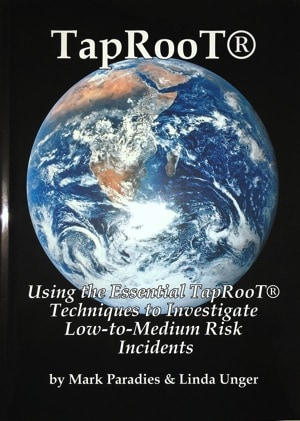Using the Essential TapRooT® Techniques to Investigate Low-to-Medium Risk Incidents

Book 3: Using the Essential TapRooT® Techniques to Investigate Low-to-Medium Risk Incidents
• • •
Book 3 of our 10-book series, Using the Essential TapRooT® Techniques to Investigate Low-to-Medium Risk Incidents, is about how to do a TapRooT® Root Cause Analysis investigation from start to finish. It discusses ALL the essential TapRooT® techniques used in the TapRooT® Root Cause Analysis process. (To learn about how to do a TapRooT® Root Cause Analysis investigation for a major investigation using advanced techniques for information collection, see our major investigation book.)
Who should read Using the Essential TapRooT® Techniques to Investigate Low-to-Medium Risk Incidents?
This book, Using the Essential TapRooT® Techniques to Investigate Low-to-Medium Risk Incidents, is the perfect desktop reference for TapRooT® investigators, as well as a great resource for those who do not currently use TapRooT® and have always wondered how it is used to identify root causes and develop corrective actions in an incident investigation.
Book Contents
Chapter 1: When is a basic investigation good enough?
Everyone defines “basic investigation” differently, but if you really want to get to the root causes of incidents and accidents and develop effective corrective actions, there are important considerations. This chapter explains why “quick and easy” investigations are often ineffective, and why you might not be getting the results you need. Find out how to make the time you spend in your basic investigations productive!
Chapter 2: How to investigate a fairly simple problem using the basic tools of the TapRooT® Root Cause Analysis System.
This chapter explains all of the TapRooT® tools that are used, and steps that are taken in the TapRooT® Process when investigating a low-to-medium risk incident. You’ll learn about building a SnapCharT®, a visual timeline and central repository for information collection. You’ll learn about how to identify Causal Factors, the mistakes, errors or equipment failures that led to the incident. But you won’t stop there – “fixing” Causal Factors is the mistake a lot of investigators make only to have the incident happen again so identifying them is only one step of the process. You’ll learn how to take Causal Factors through the TapRooT® Root Cause Tree®. The TapRooT® Root Cause Tree® guides the investigator to ask the right questions, it’s like having a human factors expert on your team! Finally, how to develop effective corrective actions will be discussed.
Chapter 3: Comparing the results of a 5-Why investigation to a basic TapRooT® investigation.
5-Whys is often the “go-to” in a low risk/low consequence investigation so we thought it was important to talk about it. Learn why using the TapRooT® Essential Techniques is a better choice for solving problems at your facility.
Appendix A: Quick Reference: How to Perform a Basic TapRooT® Investigation using Essential TapRooT® Techniques
This Appendix is just one reason this book is a great desktop reference. The book itself is an easy read with a small investment of time – it’s only 50 pages! But we still provide notes in the Appendix for quick review and better understanding of how the TapRooT® Root Cause Analysis System works.
About the Authors
Mark Paradies has 42 years of experience in high-reliability organizations, process safety, incident investigation, and root cause analysis. His career started as a leader in Admiral Rickover’s Nuclear Navy (where he earned Engineer Qualification). He also worked for DuPont in the areas of human factors, process safety, and performance improvement management before he started System Improvements in 1988. He has a BS in Electrical Engineering and an MS in Nuclear Engineering (with an emphasis on human factors), both from the University of Illinois.
Linda Unger has 36 years of experience in engineering, process safety oversight, incident investigation, and root cause analysis system implementation. She started her career at DuPont in an engineering group that also performed process safety oversight and incident investigation. She joined System Improvements in 1990 where she helped create the TapRooT® System. She has a BS in Electrical Engineering from the University of Tennessee and human factors training from the University of Michigan.
You can now purchase the complete TapRooT® 10-Book Set
Now that we have completed the TapRooT® Root Cause Analysis book series, we have produced a TapRooT® 10-book set. Here is the description, and you may purchase the 10-book set on the TapRooT® Store.
If you want to get started improving your investigations right away, order Book 3 today.



